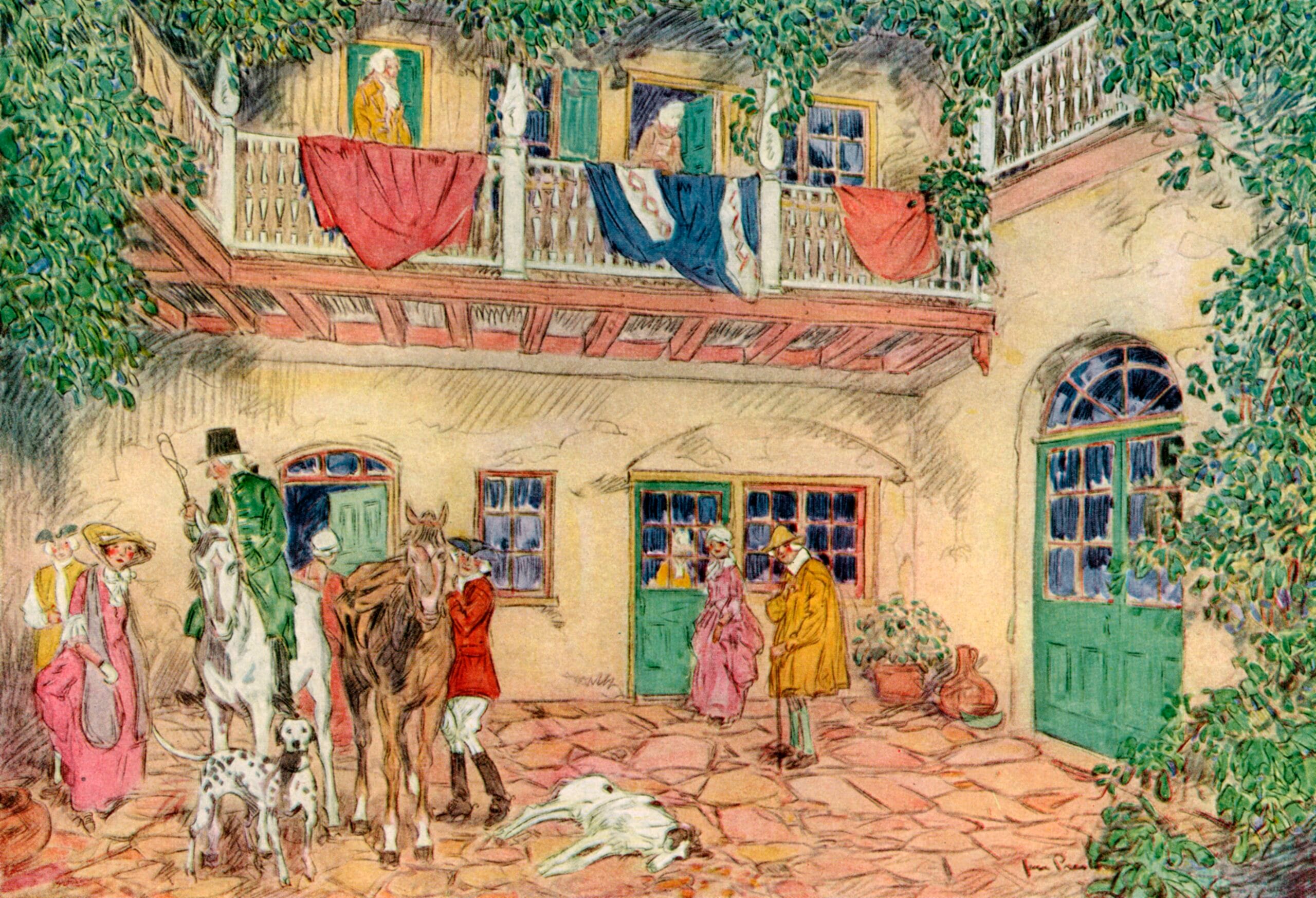Get ready to explore the creepy and spine-chilling past of Madame Lalaurie’s mansion at 1140 Royal Street in New Orleans. This place was once the home of a respected lady with a wicked secret. She tortured enslaved people in her basement, but her dirty deeds were kept hidden by the city’s elite. Then, a fire in 1834 spilled her sins, and her name will forever be known as one of the darkest in American history. Let’s take a peek into the shadows of Madame Lalaurie’s House of Horrors and uncover the horrifying truth about this infamous lady.
The Twisted Truth Behind a New Orleans Nightmare
Madame Lalaurie. The name alone sends shivers down your spine, conjuring images of a bygone New Orleans shrouded in secrets and whispers of unspeakable acts. She was a high-society darling, a queen of lavish balls and extravagant gatherings. But behind her charming smile and elegant gowns lurked a monster.
Uncover the story of Madame Delphine Lalaurie, the notorious New Orleans socialite whose gruesome crimes shocked the city in the 19th century.
You see, Madame Lalaurie lived a double life. While the cream of New Orleans society sipped champagne in her parlor, the enslaved people she held captive suffered unimaginable horrors in her attic. Their cries for mercy were swallowed by the mansion walls, their torment hidden from the prying eyes of a city blinded by its own privilege.
Then, one night in 1834, a fire ripped through the Lalaurie mansion. As firefighters battled the flames, they stumbled upon a scene of unimaginable cruelty. Enslaved people, bearing the scars of torture and abuse, were discovered chained and imprisoned in the attic. Word of the gruesome discovery spread like wildfire, igniting the fury of a city finally forced to confront the evil lurking beneath its surface.
The enraged citizens of New Orleans demanded justice. But Madame Lalaurie, clever and connected, managed to escape their grasp. She vanished into the night, leaving behind a legacy of horror that would forever stain the history of the city. Some say she fled to Paris, others whisper of a life lived under an assumed identity. The truth, much like Madame Lalaurie herself, remains elusive.
While the passage of time might have dimmed the memory of her crimes for some, the legend of Madame Lalaurie continues to captivate and horrify. Her story serves as a chilling reminder of the darkness that can fester behind a veneer of respectability, a stark illustration of the capacity for human cruelty.
Even today, historians and researchers are piecing together the fragments of her life, attempting to separate fact from the sensationalized tales that have woven themselves into the fabric of New Orleans folklore. The task is a daunting one. So much about Madame Lalaurie remains shrouded in mystery. But with each new discovery, we gain a deeper understanding of the woman behind the monster, and the societal ills that allowed her reign of terror to flourish.
What Did Madame Lalaurie Do?
Madame Lalaurie’s elegant New Orleans mansion hid a dark secret. Behind the lavish parties and charming smiles, she harbored a horrifying cruelty towards the enslaved people in her care. We’re not just talking about harsh punishments like whippings, which were sadly common in those times. Lalaurie’s actions went far beyond that, into a realm of true evil. She seemed to take pleasure in inflicting pain, both physical and mental.
Whispers of her cruelty circulated for years. There were stories of enslaved people being brutally whipped and branded. Some people believe she even kept a torture chamber in her attic, a hidden space where unspeakable acts took place. It’s said she would starve her victims, leaving them weak and vulnerable, and subject them to twisted “experiments” that defied all sense of human decency. Imagine the terror they must have felt, trapped in that house with no escape from her wickedness.
The truth of what happened behind closed doors might have stayed hidden if not for a fire that broke out in her mansion in 1834. When firefighters rushed in to battle the flames, they stumbled upon a scene of unimaginable horror in the attic. There they found several enslaved people, chained and emaciated, bearing the scars of torture. Some were bound in contorted positions, their bodies broken and disfigured. Others showed signs of cruel medical experiments, their minds and bodies shattered by her twisted curiosity.
The discovery sent shockwaves through New Orleans. People had heard rumors, but to see the evidence firsthand, to witness the depths of Lalaurie’s depravity, was deeply disturbing. It forced them to confront the brutal reality of slavery and the depths of human cruelty that lurked beneath the surface of their seemingly civilized society.
While we might never know the full extent of what happened inside those walls, the events that came to light paint a chilling picture of Madame Lalaurie’s true nature. Her story serves as a stark reminder of the horrors of slavery and the importance of fighting against all forms of injustice.
The Baby on the Roof
Madame Lalaurie’s cruelty knew no bounds, as evidenced by the tragic story of a young enslaved girl living under her roof. While the specifics of the child’s age remain unclear, some accounts refer to her as a young girl, while others suggest she may have been as young as a toddler. What we do know is that Lalaurie’s horrific treatment drove this poor child to make a desperate and tragic decision.
Whipped mercilessly, the terrified girl tried to escape Lalaurie’s wrath by climbing to the mansion’s roof. But Lalaurie, apparently enraged, pursued her. Sadly, the little girl, trapped and terrified, plunged from the rooftop to her death. The horrifying incident shocked New Orleans, forever branding Lalaurie’s name with this act of unspeakable cruelty.
This tragic event, though, wasn’t an isolated one. The stories surrounding Madame Lalaurie paint a disturbing picture of her character. Before this tragic fall, rumors had already begun to circulate about the horrors happening within the walls of her Royal Street mansion. While she presented an image of wealth and refinement to the outside world, behind closed doors, she was a cruel mistress who inflicted unspeakable suffering upon the enslaved people in her care.
The death of the young girl on the roof, whether an infant or a child just a bit older, stands out as a chilling example of Lalaurie’s brutality. It serves as a grim reminder of the horrors endured by enslaved people and the depths of depravity that humans can reach. Even though Lalaurie herself escaped true justice, her story continues to haunt the history of New Orleans, reminding us of the dark side that can lurk beneath a veneer of respectability.
Did Nicolas Cage Own the LaLaurie House?
Nicolas Cage, a man known for his eccentric taste and love for the macabre, once called the infamous LaLaurie Mansion his own. Constructed back in the 1830s, this New Orleans mansion carries a chilling history as the former residence of Delphine LaLaurie. It was within the walls of this grand home that she committed unspeakable acts, torturing and killing enslaved people hidden away in her attic.
In 2006, Cage, perhaps drawn to its dark allure and gruesome tales, purchased the mansion for a cool $3.4 million. It seemed his fascination with the darker side of history, particularly anything horror-related, led him to this notorious address.
Sadly, Cage’s time as the mansion’s master was short-lived. Financial troubles caught up with him in 2009, forcing him to relinquish the property in a foreclosure. Today, the LaLaurie Mansion rests in the hands of a wealthy Texan businessman, his identity remaining a well-guarded secret, adding another layer of intrigue to the home’s mystique.
While Cage’s ownership might have been a fleeting chapter in the mansion’s long history, the public remains captivated by this spooky piece of New Orleans. Its gruesome past and the persistent whispers of it being one of the most haunted spots in the city continue to draw everyone from paranormal investigators hoping for a glimpse of the supernatural to curious tourists eager to feel a shiver of fear. The fact that the mansion is closed off from public view only deepens its mystery, making it an object of endless fascination and speculation.
- Senior at What Age: Benefits & Eligibility Guide - March 29, 2025
- Unlocking Senior Benefits: How Old is a Senior? Your Complete Guide - March 29, 2025
- Master Russian Politeness:A Guide to Saying Please - March 29, 2025

















2 thoughts on “Madame Lalaurie’s House of Horrors: The Untold Story of New Orleans’ Most Infamous Socialite”
Comments are closed.